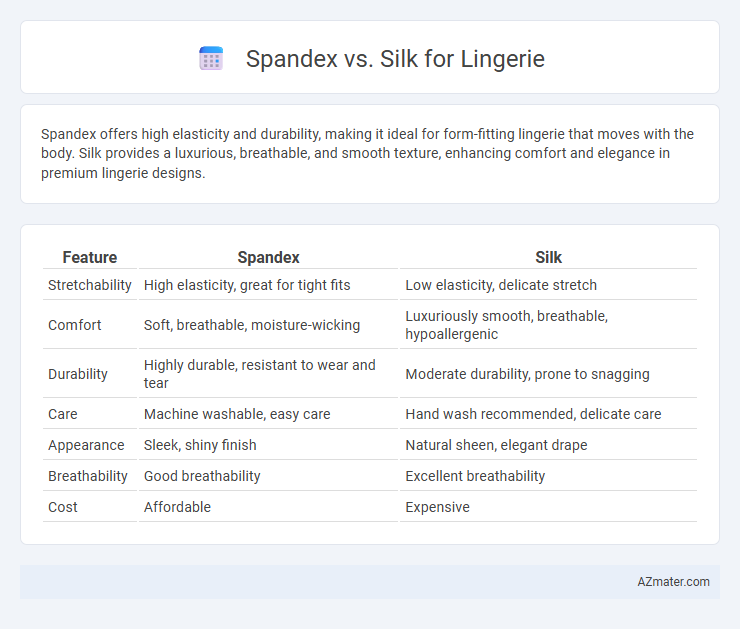Spandex offers high elasticity and durability, making it ideal for form-fitting lingerie that moves with the body. Silk provides a luxurious, breathable, and smooth texture, enhancing comfort and elegance in premium lingerie designs.
Table of Comparison
| Feature | Spandex | Silk |
|---|---|---|
| Stretchability | High elasticity, great for tight fits | Low elasticity, delicate stretch |
| Comfort | Soft, breathable, moisture-wicking | Luxuriously smooth, breathable, hypoallergenic |
| Durability | Highly durable, resistant to wear and tear | Moderate durability, prone to snagging |
| Care | Machine washable, easy care | Hand wash recommended, delicate care |
| Appearance | Sleek, shiny finish | Natural sheen, elegant drape |
| Breathability | Good breathability | Excellent breathability |
| Cost | Affordable | Expensive |
Introduction to Spandex and Silk in Lingerie
Spandex, known for its exceptional elasticity and durability, offers a snug fit and excellent shape retention in lingerie, making it ideal for active comfort and body contouring. Silk, prized for its natural softness and luxurious sheen, provides a breathable and hypoallergenic option that feels gentle against the skin, enhancing sensual appeal. Both materials contribute unique benefits to lingerie design, with spandex optimizing stretch and support while silk emphasizes elegance and natural comfort.
Fabric Composition: Spandex vs Silk
Spandex, made from polyurethane fibers, offers exceptional stretch and recovery, making it ideal for form-fitting lingerie that requires flexibility and support. Silk, a natural protein fiber produced by silkworms, provides a smooth, luxurious texture with breathability and moisture-wicking properties, enhancing comfort and elegance. While spandex excels in elasticity and durability, silk stands out for its softness and temperature regulation, influencing lingerie choice based on desired feel and function.
Comfort and Feel: Which is Softer?
Silk offers unparalleled softness and a natural smoothness that feels luxurious against the skin, making it the preferred choice for high-end lingerie focused on comfort and elegance. Spandex, while stretchy and form-fitting, provides a snug feel but lacks the natural softness and breathability found in silk. For those prioritizing softness and a gentle touch, silk lingerie delivers a superior sensory experience compared to the synthetic texture of spandex blends.
Breathability and Moisture Control
Spandex offers superior stretch and shape retention but lacks breathability and moisture-wicking properties, often trapping heat and sweat during extended wear. In contrast, silk excels in breathability and moisture control due to its natural protein fibers, which allow air circulation and absorb moisture without feeling damp. Choosing silk over spandex enhances comfort in lingerie by preventing overheating and promoting a dry, breathable fit.
Durability and Longevity of Spandex and Silk Lingerie
Spandex lingerie offers exceptional durability and elasticity, maintaining its shape and resilience after multiple wears and washes, making it ideal for long-term use. Silk lingerie, while luxurious and soft, requires more delicate care and is prone to wear and tear over time, reducing its longevity compared to spandex. Choosing spandex ensures a longer-lasting lingerie option, especially for active or frequent use, whereas silk provides premium comfort with more careful handling.
Stretch and Fit: Body-Hugging Qualities
Spandex offers superior stretch and elasticity, allowing lingerie to contour closely to the body and provide a snug, body-hugging fit that moves with every curve. Silk, while naturally soft and smooth against the skin, lacks the stretch capability, resulting in a more relaxed fit that drapes rather than clings. For lingerie focused on shaping and support, spandex blends excel in maintaining shape and flexibility throughout wear.
Care and Maintenance Requirements
Spandex lingerie requires gentle washing in cold water and air drying to maintain elasticity and prevent fabric damage, while avoiding bleach and high heat. Silk lingerie demands delicate hand washing or using specialized silk detergents, avoiding harsh chemicals and direct sunlight to preserve its natural fibers. Proper storage in a cool, dry place is essential for both fabrics to extend their lifespan and maintain softness.
Cost Comparison: Spandex vs Silk Lingerie
Spandex lingerie is generally more affordable due to its synthetic manufacturing process, with prices typically ranging from $10 to $50 per piece. Silk lingerie, crafted from natural fibers and requiring more intricate production, usually costs between $50 and $200 or more. The price difference reflects the material quality, durability, and luxury associated with silk compared to the budget-friendly and stretchy comfort of spandex.
Best Uses and Style Choices for Each Fabric
Spandex is ideal for lingerie that demands stretch, support, and durability, making it perfect for everyday wear, shaping garments, and active lingerie styles such as sports bras and thong panties. Silk offers a luxurious, smooth texture and natural breathability, best suited for elegant, sensual lingerie like slips, chemises, and robes that prioritize comfort and sophisticated style. Choosing between spandex and silk hinges on the desired combination of firmness, flexibility, and aesthetic appeal in lingerie design.
Choosing the Right Fabric for Your Lingerie Needs
Spandex offers exceptional stretch and durability, making it ideal for form-fitting lingerie that moves with the body and provides lasting comfort. Silk delivers a luxurious feel and natural breathability, perfect for delicate, sensual pieces that prioritize elegance and softness against the skin. Choosing between spandex and silk hinges on whether you value elasticity and support or indulgent comfort and aesthetic appeal in your lingerie collection.

Infographic: Spandex vs Silk for Lingerie
 azmater.com
azmater.com